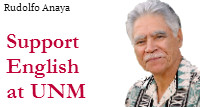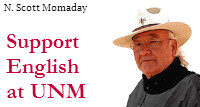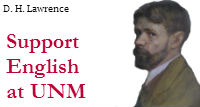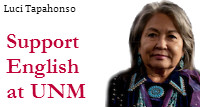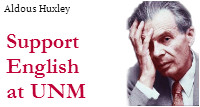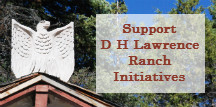Fall 2018 Course Descriptions
500 Level
500.001: Introduction to Professional Study of English
TR 1230-1345
Jesús Costantino, jcostantino@unm.edu
This course prepares first-semester M.A. and Ph.D. students in English for graduate study and professional life. The first half of the course will provide you with a thorough anatomy of a graduate and professional career in English. The focus here will be on bringing into the light of day the otherwise invisible structures, concepts, and everyday habits of “doing” English for a living. In this first half, you will develop skills and strategies aimed at preparing you to succeed in each phase of a graduate career, from coursework and graduate-level research to qualifying exams, thesis/dissertation, conferences, publications, pedagogy, the job search (both academic and alt-ac), and more. While the first half of the course interrogates the “what” of the professional study of English, the second half digs deeply into the “why.” In this second part of the course, we will reflect historically and philosophically upon English as a discipline and academia as a profession. We will think critically about our shared assumptions about the practices we implement (writing, pedagogy, and critique) and the values we seek to foster in our scholarly work (accessibility, community, and joy). By reexamining our textual objects of inquiry, considering the relationship between scholarship and teaching, and contemplating the changing nature of academic labor and the university workplace, the course will prepare students to navigate their graduate degrees and professional lives both knowledgably and purposefully.
513.001: Scientific, Environmental, & Medical Writing
MW 1600-1715
Michelle Kells, mkells@unm.edu
515.001: Publishing
R 1900-2130
David Dunaway, dunaway@unm.edu
520.001: T: Blue Mesa Review
Mark Sundeen, marksundeen@unm.edu
This class introduces you to the production of UNM’s national literary magazine, Blue Mesa Review. We receive hundreds and sometimes thousands of submissions each year from authors hoping to see their stories, essays, or poems published in our journal. Your primary responsibility in this course is to assess these submissions—collectively called “slush”—for possible publication in BMR. In addition, you will keep an informal journal about your participation in slush, attend discussion meetings, and write a few short papers. This class requires you to be self-motivating; in some respects, it is very much like an independent study. You must be able to keep up with the workload on your own—and often on your own time.
521.001: Creative Writing Workshop - Fiction
T 1600-1830
Julie Shigekuni, jshig@unm.edu
Your stories will form the basis for this workshop. We will focus on authorial vision and how writers discover through creative exploration their place in the world and voice on the page. In addition to weekly critique of participant work, you will read published work to deepen your understanding of setting, and how the cultural and historic, internal and external contribute to an author's vision and voice. Readings will include excerpts from Gita Sereny's Into That Darkness, Philip Roth's The Plot Against America, John Okada's No-No Boy, Juan Rulfo's Pedro Paramo, and Leslie Marmon Silko'sCeremony. You are encouraged to buy these books and read them ahead in their entirety as our time together during the fall will allow only for excerpts.
522.001: Creative Writing Workshop - Poetry
W 1600-1830
Lisa Chavez, ldchavez@unm.edu
This graduate workshop in poetry will focus on generating new material and revising poems in progress. While much of the class will be focused on workshopping student poems, we will also do writing exercises in class to help generate new work (including writing exercises led by students in the class). We will also read and discuss a variety of books by contemporary poets.
523.001: Creative Writing Workshop - Non-Fiction
R 1600-1830
Mark Sundeen, marksundeen@unm.edu
This is a workshop-based course for writing memoir, personal essay, lyrical prose, narrative journalism, travel writing, and any hybrid thereof. Each student will submit three pieces over the course of the semester to be discussed in class. Workshops will focus on five basic elements of craft: voice, character, theme, structure, and plot. We will also hone the skill of providing verbal and written feedback: learning to comment on peers’ work with insights that are honest, kind, and constructive. We will read and evaluate essays by contemporary innovators of creative nonfiction. Poets and fiction writers are welcome!
530.001: Teaching Composition
August 2-August 3 - RF 0900-1300
August 6-August 16 - MTWRF 0900-1300
Lab - August 20-December 10 - M 1500-1550
Todd Ruecker, truecker@unm.edu
530.002: Teaching Composition
August 6-August 16 - MTWRF 0900-1300
Lab - August 20-December 10 - M 1500-1550
Charles Paine, cpaine@unm.edu
532.001: Online & Multi-Modal Composition
August 6-August 17 - MTWRF 0900-1300
Lab - August 22-December 10 - W 1500-1530
Tiffany Bourelle, tbourell@unm.edu
In this class, students will learn the theory behind online teaching and multimodal composition. Beth Hewett and Christa Ehmann (2004) indicate that teachers are often concerned about teaching online for the first time; however, they suggest that this worry is caused by a lack of proper training. This course will prepare students to teach an online course, helping them understand the best practices of designing a course, facilitating course discussions, holding online conferences, and providing feedback. In addition, the class will also be practical, as students will develop course shells to teach in the subsequent semester (if eligible). The class students will teach will be part of our online program, eComp, which is based on a multimodal pedagogy, where first-year students are asked to choose their medium in response to the needs of their audience and the purpose of the document. As such, this English 532 class will teach students the theory and pratice of multimodal composition, helping them create materials such as assignments and multimodal instructional tools that mimic the texts our first-year students develop.
534.001: Composition Theory
T 1600-1830
Todd Ruecker, truecker@unm.edu
In this course, we will read and discuss key areas of inquiry in the field of Composition Studies, including theories of audience, invention, genre, argument, voice, process, collaboration, second language writing, multimodal composition, and assessment, among others. By the end of the course, students should emerge with a broad understanding of various theories circulating in composition and how these theories are informed by related disciplines such as applied linguistics, literacy studies, and rhetorical studies. Students will have the understanding necessary to pursue further work in a particular area as well as how these theories might inform their own pedagogy, practice, and research.
540.002: T: Rhetorics of Oppression
R 1600-1830Bethany Davila, bdavila@unm.edu
What do #AllLivesMatter, #NotAllMen, and #LoveIsLove have in common? How does language perpetuate oppression? What kinds of discursive practices get in the way of civil rights and social justice?
This class will examine these questions through a careful, structured study of language and its effects. As a class, we’ll use rhetorical analysis and discourse analysis to uncover ideologies undergirding popular discourse around equal rights and identity politics. Then, we’ll locate those ideologies in language to better understand how oppression is rhetorically and discursively perpetuated. Each student will then choose their own area of oppression to explore in depth.
Course work includes regular reading (available through Learn) and small writing assignments as well as a student-directed research project and paper.
547.001: Introductory Old English
TR 1400-1515Jonathan Davis-Secord, jwds@unm.edu
Hwæt! In this class, we will return to the earliest recorded form of English and read some of the oldest literature ever written in the language. We will spend the first half of the semester learning the grammar of Old English while working through introductory passages in their original form. We will then move on to reading Old English prose and poems, including some of Beowulf! No prior knowledge of Old English required.
550.001: Middle English Heroes, Saints & Lovers
TR 1100-1215Anita Obermeier, aobermei@unm.edu
This course is an introductory sampling of medieval literature (and some art) produced in England and the immediate Continent between 1066 and 1500. We start this historical, linguistic, and literary enterprise with the Bayeux Tapestry—art with text—fighting alongside Anglo-Saxon warriors. Then we will pray with English saints, sleuth with historians, learn the art of courtly love from medieval knights and ladies, look at the nature of God with mystics, and watch biblical drama unfold. The original texts are in Latin, Anglo-Norman, and various dialects of Middle English, which we will study in modern English, in bilingual facing-page translations, and the easier ones in Middle English. The texts cover various secular and religious genres, including epic, debate, saints’ lives,fabliau, lais, romance, drama, allegory, and lyrics. The goal of the course is to highlight the variety and range of texts of the Middle English period, and to place those writings in their cultural, linguistic, and historical contexts.
555.001: Women Writers 1740-1820: Fictions of Seduction, Rape and Courtship
TR 0930-1045
Carolyn Woodward, woodward@unm.edu
In the eighteenth and early nineteenth centuries, the novels of women writers were best-sellers. Overwhelmingly, these fictions construct coercive sexual relations. Narratives of seduction, rape and courtship pointed up power dynamics in any relations of inequality and encouraged readers to think in general about the appropriate uses and locations of authority. Some questions will be important for us: How did people in the eighteenth century understand “seduction”? “rape”? “courtship”? What was “marriage,” and what were the responsibilities and rights of a married woman? a married man? How do these women writers represent sexual desire in female characters? in male characters? We will ground our study in feminist theory by Mary Astell (1700) and Mary Wollstonecraft (1792), and we will read these novels: Eliza Haywood’s Anti-Pamela and Miss Betsy Thoughtless, Charlotte Lennox’s The Female Quixote, Sarah Fielding’s The Countess of Dellwyn, Frances Burney’s Evelina, and Jane Austen’s Pride & Prejudice.
562.001: American Realism & Naturalism
M 1600-1830Kathryn Wichelns, wichelns@unm.edu
As literary movements, American realism and naturalism express and respond to the crisis in national identity that characterizes the post-Civil War period. The era is marked by cultural shocks: demographic shifts, as non-Protestant, non-white, and non-English speaking immigration to the U.S. increases; unprecedented economic inequality, urbanization and overcrowding; federal withdrawal from the South and the rise of Jim Crow; continued Westward expansionism and the series of brutal conflicts known as the Western Indian Wars; the 1898 Spanish-American War; the emerging visibility of women workers; and an explosion in scientific and pseudoscientific discourses (including social Darwinism and eugenics) that arise in the wake of the 1859 publication of Charles Darwin’s On the Origin of Species. Writing in the period of the Gatling gun, the railroad, the telegraph, and the photograph, these authors call for an end to literary romanticism, seeking to depict life as it really is. In different ways, each examines the influences of environment, race, heredity, and gender on individual development. Mark Twain, Henry James, and Edith Wharton explore the conflicts of their own changing society through depictions of characters who most embody its values. Rebecca Harding Davis, Louisa May Alcott, W.E.B. DuBois, and Jacob Riis form new approaches to writing as activism. Sarah Orne Jewett, Zitkala-Ša, Charles W. Chesnutt, and Abraham Cahan dismantle the notion of a cohesive (Anglo-American) national identity by emphasizing differences of region, race, and ethnicity. The conflicts evident in literary expression during this dynamic era reflect profound contradictions inherent to the concept of an American national consciousness—variously understood by the authors we examine as a bad joke, a hard-won social good, a naive fantasy, or a form of colonial whitewashing.
572.001: Contemporary Literature
W 1600-1830
Scarlett Higgins, shiggins@unm.edu
This course will cover literary and cultural texts of the period post-World War II through the 1990s. We will read across genres, including poetry, prose (fiction and non-fiction), drama, and film. We will also read extensively in significant and relevant literary and cultural theories. This course will contain a special emphasis on texts responding to the socio-political tensions that defined the post-World War II era.
587.001: Image & Time in Narrative
M 1600-1830
Daniel Mueller, dmueller@unm.edu
Fiction is typically regarded as a dramatic art form, sharing with plays and films the capacity to engage an audience’s imagination in action that seems, when successful, urgent, immediate, necessary, real. When, as writers, we invest ourselves in portraying movement and rendering external conflict in scenes such that our readers may infer the internal conflicts and motivations of our characters, we are operating at our most dramatic and, at these moments, have the most in common with playwrights and filmmakers. But most fiction isn’t written in the third person objective voice, and unless we’re Hemingway writing “Hills Like White Elephants” (which makes use of an extraordinarily telling image in its title) or Carver writing “Fat,” or any number of other fiction writers whose stories resemble scripts, we can limit ourselves unnecessarily. In this course, we will examine the intersection of narration and lyricism in the interest of better appreciating the rich variety of ways images serve works of fiction. In examining how a wide variety of writers, from the avant-garde to the traditional, from the modern to post-modern to contemporary, have used images, we will come to a deeper awareness of the terrain fiction shares not only with poetry, but with painting, drawing, and photography, art forms that cannot embrace causality except by implication and find much of their meaning in stasis and compression.
592.001: Teaching Literature & Literary Studies
TR 1230-1345
Aeron Haynie, ahaynie@unm.edu
I envision this course being both a lively seminar on why we teach literature and a hands-on practicum where each of you will work on developing your own distinctive pedagogical style. We will craft informed and up-to-date teaching philosophy statements, observe others' teaching, hone our own lecture, discussion, and course design skills, and be able to satisfactory answer the question, "why study English?"
600 Level
